"Cherishing Little Steps - A Haven for Baby and Family Journeys"
Babies and Car Seat Safety
Did you know that every year, thousands of babies are injured in car accidents due to improper car seat usage? Ensuring the safety of your little one while on the road is of utmost importance, and understanding the ins and outs of car seat safety is essential.
Let’s take a moment to explore the world of babies and car seat safety together. From choosing the right car seat for your baby’s age and size to properly installing it in your vehicle, we will delve into the necessary steps to keep your precious cargo secure.
So, buckle up and let’s dive into the world of car seat safety for your little one!
Key Takeaways
- Properly securing your baby in a car seat is essential for their safety while traveling in a vehicle.
- There are three main types of car seats for babies: infant car seats, convertible car seats, and all-in-one car seats.
- Choosing the right car seat based on safety standards, age, weight, and height is crucial for your baby’s protection.
- Clear understanding of car seat regulations is crucial for your baby’s safety while traveling.
Importance of Car Seat Safety
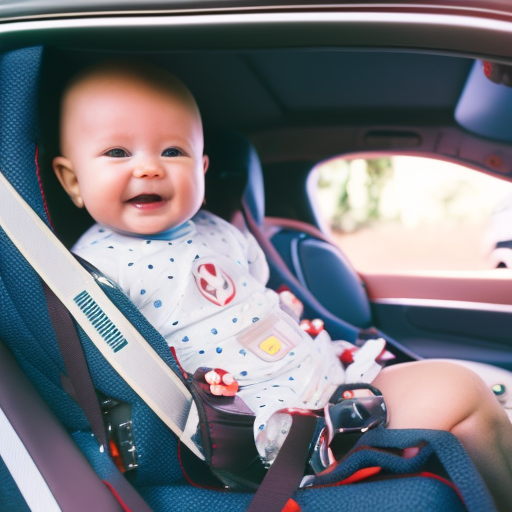
You need to prioritize car seat safety for your baby. Ensuring that your baby is properly secured in a car seat is essential for their safety while traveling in a vehicle. Car seat installation and adherence to car seat regulations are crucial aspects of this.
When it comes to car seat installation, it’s important to carefully follow the manufacturer’s instructions. This includes adjusting the seat to fit your baby’s size and weight, as well as properly securing it in the vehicle using the seat belts or LATCH system. Incorrect installation can significantly compromise the effectiveness of the car seat in protecting your baby in the event of a crash.
Additionally, it’s vital to stay up to date with the latest car seat regulations. These regulations are in place to ensure that car seats meet the highest safety standards. They may include guidelines on the type of car seat appropriate for your baby’s age and weight, as well as recommendations on when to transition to a different type of seat.
Types of Car Seats for Babies
What are the different types of car seats available for your baby, and how do they differ in terms of safety and suitability?
Choosing the right car seat for your baby is crucial to ensure their safety while traveling. There are three main types of car seats for babies: infant car seats, convertible car seats, and all-in-one car seats.
Infant car seats are specifically designed for newborns and infants up to 35 pounds. They’re rear-facing and come with a detachable carrier, allowing you to easily transport your baby in and out of the car without disturbing their sleep. These seats provide excellent protection for your little one’s head, neck, and spine.
Convertible car seats can be used in both rear-facing and forward-facing positions. They’re designed to accommodate babies from birth up to 65 pounds. While they offer a longer lifespan than infant car seats, they aren’t as portable.
All-in-one car seats are the most versatile option as they can be used from infancy to toddlerhood and beyond. They can be used in rear-facing, forward-facing, and even booster seat modes. Although they’re convenient, keep in mind that they may not provide the same level of comfort and support as dedicated infant or convertible car seats.
When choosing a car seat for your baby, always prioritize safety, ensuring that it meets the latest safety standards and is installed correctly in your vehicle. Consider your baby’s age, weight, and height, as well as your specific needs for convenience and versatility. Remember, the right car seat can make a significant difference in protecting your child in case of an accident.
Choosing the Right Car Seat
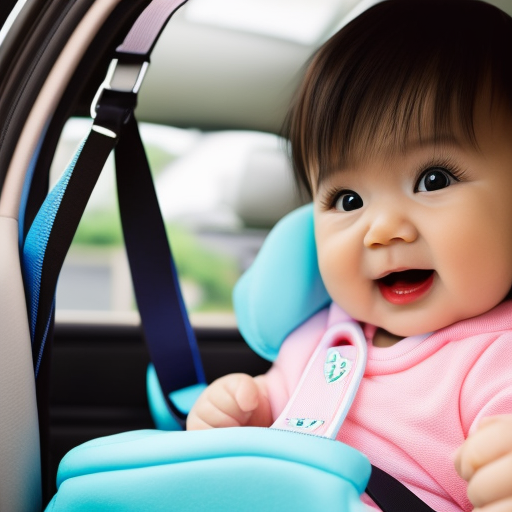
Selecting the appropriate car seat for your baby is a critical decision that directly impacts their safety during travel. When choosing the right car seat, there are several factors to consider to ensure your baby’s comfort and protection.
The table below provides a quick overview of the different types of car seats, their features, and the age range they are suitable for:
| Car Seat Type | Features | Age Range |
|---|---|---|
| Rear-Facing Infant Car Seat | Portable, lightweight, detachable carrier | Birth to 2 years |
| Convertible Car Seat | Can be used rear-facing and forward-facing | Birth to 4 years |
| Forward-Facing Car Seat | Offers harness and tether for added safety | 2 to 5 years |
| Booster Seat | Raises child to proper height for seat belt use | 4 to 12 years |
| All-in-One Car Seat | Converts from rear-facing to booster seat | Birth to 12 years |
When making your decision, consider your baby’s age, weight, and height, as well as the car’s make and model. It is essential to choose a car seat that meets safety standards and fits securely in your vehicle. Additionally, ensure that the seat is easy to install and adjust, as this will make your life easier when traveling with your baby.
Understanding Car Seat Regulations
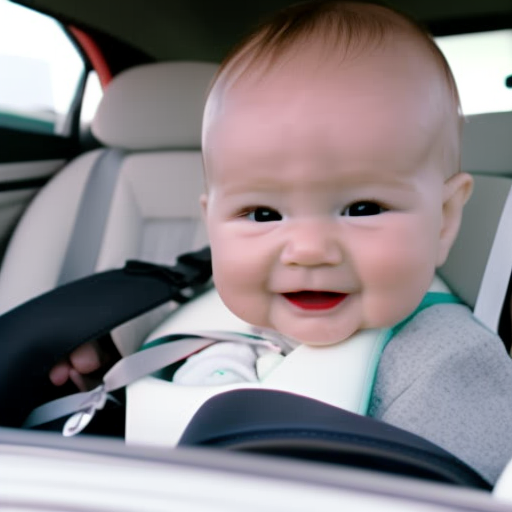
To ensure the safety of your baby while traveling, it’s important to have a clear understanding of car seat regulations. Understanding car seat regulations is crucial because they’re designed to protect your child in the event of a car accident or sudden stop. Safety standards and guidelines are in place to ensure that car seats are properly installed and used correctly.
Firstly, it’s essential to choose a car seat that meets the safety standards set by regulatory authorities. Look for car seats that have been tested and approved by reputable organizations such as the National Highway Traffic Safety Administration (NHTSA) or the American Academy of Pediatrics (AAP). These organizations regularly update their guidelines to reflect the latest research and best practices for car seat safety.
Secondly, it’s important to follow the manufacturer’s instructions for installation and use. Each car seat may have specific guidelines for proper installation, securing your baby, and adjusting the harness straps. Make sure to read the instruction manual carefully and consult with a certified child passenger safety technician if you have any questions or need assistance.
Lastly, keep in mind that car seats have expiration dates. Over time, the materials of a car seat may deteriorate, compromising its ability to protect your baby in a crash. It’s recommended to check the expiration date on your car seat and replace it if it has expired.
Proper Installation of Car Seats
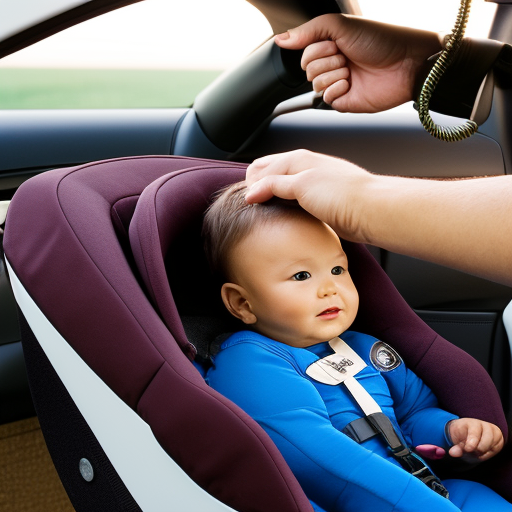
To ensure the safety of your baby, you should properly install the car seat using the manufacturer’s guidelines and secure it in accordance with car seat regulations. Proper installation is crucial because it ensures that the car seat functions as intended during a crash or sudden stop.
Start by reading the car seat’s instruction manual thoroughly. It will provide detailed guidance on how to install the seat correctly. Follow the manufacturer’s guidelines step-by-step, paying close attention to the specific instructions for your car model and seat type.
When installing the car seat, make sure it’s tightly secured. Check for any movement by firmly pushing and pulling the seat in different directions. A properly installed car seat shouldn’t move more than an inch in any direction.
Additionally, always use the correct type of seat belt or LATCH system to secure the car seat. Be sure to route the seat belt or LATCH strap through the appropriate slots provided by the car seat manufacturer.
Remember to periodically check the car seat’s installation to ensure it remains secure. As your baby grows, you may need to adjust the seat position or switch to a different car seat model that’s suitable for their size and weight.
Securing Your Baby in the Car Seat
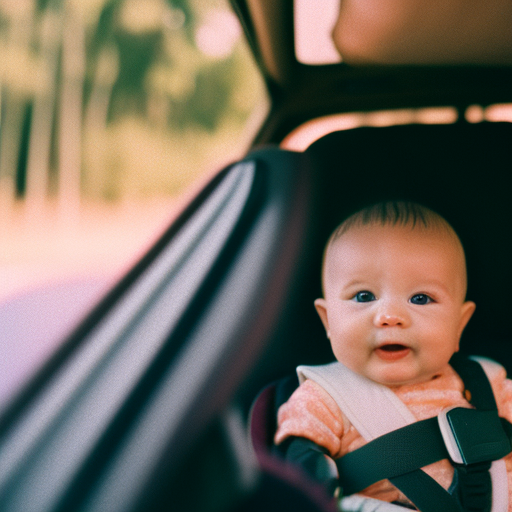
Make sure you use the appropriate straps to securely fasten your baby in the car seat. It’s crucial to follow proper securing techniques to ensure your baby’s safety. Here are some key points to keep in mind:
-
Harness Positioning: Ensure that the harness straps are at or below your baby’s shoulders. This helps keep your baby secure and prevents them from sliding out of the harness during a sudden stop or collision.
-
Tightness: The harness should be snug enough that you can’t pinch any excess webbing at your baby’s shoulders. This ensures that your baby is properly restrained and minimizes the risk of injury in the event of an accident.
-
Chest Clip Placement: The chest clip should be positioned at armpit level, resting on your baby’s chest. This helps distribute the forces of a crash and prevents the harness straps from sliding off your baby’s shoulders.
-
Avoid Common Errors: Some common errors include using aftermarket products that haven’t been crash-tested, adding bulky clothing that prevents a secure harness fit, and using an expired or damaged car seat. Avoid these mistakes to ensure your baby’s safety.
By following these securing techniques and avoiding common errors, you can provide your baby with the utmost protection while traveling in the car.
Adjusting the Car Seat as Your Baby Grows

As your baby grows, it’s important to make necessary adjustments to the car seat to ensure their continued safety and comfort.
One crucial aspect to consider is adjusting the straps. As your baby gets taller and heavier, you’ll need to loosen the straps to accommodate their increasing size. Check that the straps are snug against their shoulders, but not too tight that it restricts their movement or causes discomfort.
It’s also essential to regularly examine the reclining positions of the car seat. Newborns and infants need a more reclined position to support their fragile neck and spine. However, as your baby grows and gains more head control, you can gradually adjust the seat to a more upright position. This will provide them with a better view of their surroundings and ensure their comfort during the ride.
Common Mistakes to Avoid With Car Seats

When it comes to car seat safety, there are common mistakes that you need to avoid for your baby’s protection. Proper installation of a car seat is crucial to ensure your child’s safety during travel. Here are some common mistakes to avoid and the importance of proper installation:
-
Incorrect installation: Make sure to carefully follow the manufacturer’s instructions when installing the car seat. Improper installation can lead to serious injuries in case of an accident.
-
Loose straps: Always check that the straps are securely tightened. Loose straps can lead to your baby being ejected from the car seat during a crash.
-
Forward-facing too early: It’s essential to keep your child rear-facing for as long as possible. This position provides better support for their head, neck, and spine, reducing the risk of injury.
-
Using an expired or damaged car seat: Car seats have an expiration date, usually around six years after the manufacturing date. Using an expired or damaged car seat may compromise its effectiveness in protecting your baby.
Proper installation of a car seat is of utmost importance to ensure your baby’s safety on the road. By avoiding these common mistakes, you can provide your child with the safest possible journey.
Tips for Traveling Safely With a Baby
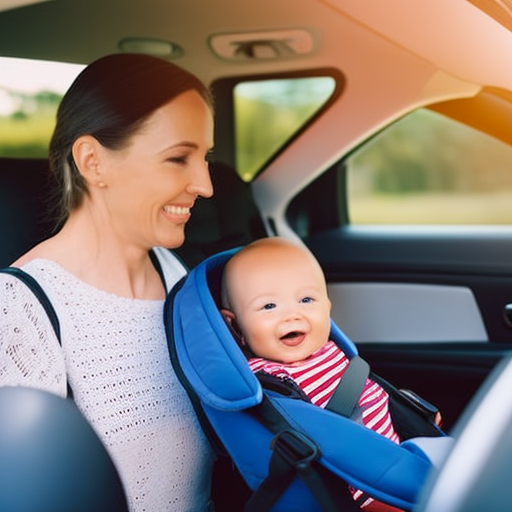
To ensure a safe journey for your baby, it’s important to follow these tips for traveling with your little one.
When traveling with infants, it’s crucial to adhere to car seat guidelines. Firstly, make sure that your baby’s car seat is appropriate for their age, weight, and height. Use a rear-facing car seat for infants under 1 year old or weighing less than 20 pounds. This position provides optimal protection for their developing neck and spinal cord.
Secondly, secure the car seat properly in the backseat of the vehicle, using either the seat belt or the LATCH system. Ensure that the car seat is tightly installed and doesn’t move more than an inch in any direction.
Thirdly, always place your baby in the car seat and buckle them up correctly. The harness straps should be snug, with no more than one finger’s width of space between the strap and your baby’s collarbone.
Lastly, avoid using aftermarket accessories, such as headrests or cushions, as they can compromise the safety of the car seat.
Car Seat Safety Checks and Inspections
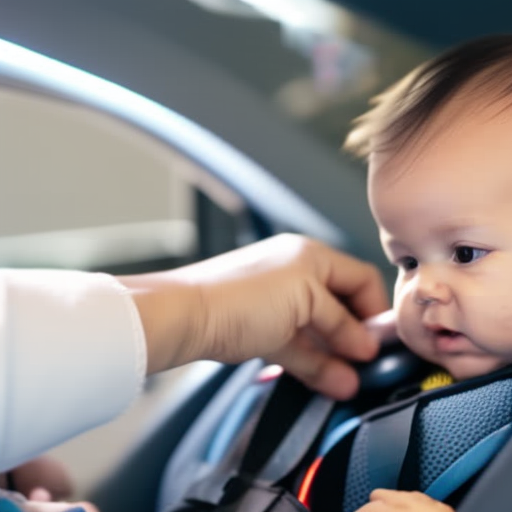
To ensure the effectiveness of your baby’s car seat, it’s crucial to regularly perform car seat safety checks and inspections. By following these car seat safety guidelines, you can ensure the safety of your little one while on the road:
-
Check for proper installation: Make sure the car seat is securely installed in your vehicle. Ensure that the seat is tightly fastened and doesn’t move more than an inch in any direction.
-
Inspect the harness: Ensure that the harness is snug and fits your baby properly. The straps should be at or below your baby’s shoulders, and there should be no slack in the straps.
-
Check for damage: Regularly inspect the car seat for any signs of wear and tear, such as frayed straps or cracks in the frame. If you notice any damage, it’s essential to replace the car seat immediately.
-
Stay up to date with safety recalls: Stay informed about any safety recalls for your car seat model. Register your car seat with the manufacturer to receive recall notifications, and promptly address any issues.
Extended Rear-Facing: Why It Matters

Keep your baby safe on the road by understanding why extended rear-facing is crucial for their protection. Rear facing benefits are well-documented and supported by car seat safety experts. It’s recommended that children remain in a rear-facing car seat for as long as possible, until they reach the maximum height or weight limit specified by the car seat manufacturer. The American Academy of Pediatrics (AAP) recommends rear-facing until at least 2 years old, but recent research suggests that even longer is better.
Extended rear facing guidelines vary depending on the car seat model and the child’s size, but the general consensus is that it provides optimal protection. When a child is rear-facing, the force of a crash is distributed evenly across their entire body, reducing the risk of head, neck, and spinal injuries. The rear-facing position also provides better support for a baby’s developing head and neck muscles.
Remember that car seats are specifically designed to protect your child, and following the recommended guidelines is crucial for their safety. While it may be tempting to turn your child forward-facing earlier, it’s important to prioritize their protection over convenience. By keeping your child rear-facing for extended periods, you’re giving them the best chance of surviving and avoiding serious injuries in the event of a car accident.
Transitioning to a Forward-Facing Car Seat

When your baby reaches the appropriate height and weight limits, it’s time to transition them to a forward-facing car seat. This is an important milestone in ensuring your child’s safety during car rides.
Here are some key points to keep in mind during this transition:
-
Age Requirements: Follow the guidelines provided by the car seat manufacturer and your local laws regarding when it’s safe to transition to a forward-facing car seat. Generally, this transition occurs around the age of two or when your child outgrows their rear-facing car seat.
-
Check Height and Weight: Ensure that your child meets the height and weight requirements specified by the car seat manufacturer for using a forward-facing seat. These limits are in place to provide optimal protection in the event of a collision.
-
Installation and Adjustment: Take the time to properly install and adjust the forward-facing car seat according to the manufacturer’s instructions. This includes securing the seat tightly and adjusting the harness to fit snugly against your child’s body.
-
Continued Safety Measures: Even when transitioning to a forward-facing car seat, it’s crucial to continue following all other car seat safety guidelines, such as using a seatbelt to secure the car seat and not placing any bulky objects or cushions that may interfere with proper restraint.
Frequently Asked Questions
How Do I Clean My Baby’s Car Seat?
To clean your baby’s car seat, follow these tips for car seat maintenance: Start by removing the cover and straps, then wash them according to the manufacturer’s instructions. For any spills or stains, use a mild soap and warm water to gently scrub. Allow everything to air dry before reassembling.
Can I Use a Second-Hand Car Seat for My Baby?
You should always prioritize your baby’s safety when it comes to car seats. Buying second-hand seats can raise safety concerns, so make sure to thoroughly check for proper installation, expiration dates, and cleanliness.
When Should I Switch My Baby From an Infant Car Seat to a Convertible Car Seat?
When to switch your baby from an infant car seat to a convertible car seat depends on their weight and height. Follow safety guidelines to ensure your little one is protected while traveling.
Are There Any Additional Safety Accessories I Should Consider for My Baby’s Car Seat?
When it comes to car seat safety, there are some additional accessories you should consider. These can include things like seat protectors, mirrors for rear-facing seats, and strap covers. Always follow car seat safety guidelines for maximum protection.
Can My Baby Sleep in Their Car Seat Outside of the Car?
Yes, your baby can sleep in their car seat outside of the car, but it’s not recommended for prolonged periods. It’s important to follow car seat safety guidelines and prioritize your baby’s comfort and well-being.
Conclusion
When it comes to car seat safety for babies, there’s no room for compromise.
Remember, choosing the right car seat, understanding regulations, and proper installation are essential.
Just like a shield protecting a knight, a car seat shields your little one from harm during travel.
So, make sure to prioritize their safety and follow all guidelines.
Remember, a secure car seat is like a guardian angel for your precious bundle of joy.


